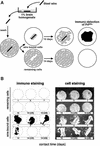Transmission of prions
- PMID: 12181490
- PMCID: PMC139897
- DOI: 10.1073/pnas.172403799
Transmission of prions
Abstract
The "protein only" hypothesis states that the infectious agent causing transmissible spongiform encephalopathies is a conformational isomer of PrP, a host protein predominantly expressed in brain, and is strongly supported by many lines of evidence. Prion diseases are so far unique among conformational diseases in that they are transmissible, not only experimentally but also by natural routes, mainly by ingestion. A striking feature of prions is their extraordinary resistance to conventional sterilization procedures, and their capacity to bind to surfaces of metal and plastic without losing infectivity. This property, first observed in a clinical setting, is now being investigated in experimental settings, both in animals and in cell culture.
Figures





References
-
- Will R G, Ironside J W, Zeidler M, Cousens S N, Estibeiro K, Alperovitch A, Poser S, Pocchiari M, Hofman A, Smith P G. Lancet. 1996;347:921–925. - PubMed
-
- Cuille J, Chelle P L. C R Seances Acad Sci. 1939;208:1058–1160.
-
- Gordon W S. Vet Rec. 1946;58:516–520. - PubMed
-
- Alper T, Cramp W A, Haig D A, Clarke M C. Nature (London) 1967;214:764–766. - PubMed
-
- Griffith J S. Nature (London) 1967;215:1043–1044. - PubMed
MeSH terms
LinkOut - more resources
Full Text Sources
Research Materials

